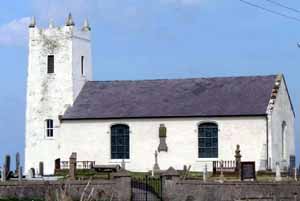|
|
|
Ballintoy
 |
BALLINTOY
(Baile an Tuaighe - The place of
the axe)
There is a dramatic approach to the village
from the Eastern (Ballycastle) side. Suddenly below, set in a turquoise sea, is
Sheep Island. In hard times sheep were taken to the island which was said to
have enough grass to fatten 10 sheep, to feed 11 sheep or to famish 12 sheep.
From the crest of the road you descend the Icehouse Brae. Look on the left for
the Icehouse. Again the road climbs to a crest from where a panoramic view of
Ballintoy and its environs can be seen.
Unseen to the right is the Island of Carrick-a-rede (the rock in the road) which is joined to the mainland by its famous rope bridge, used by salmon fishermen for several centuries. Below is the bay with its stalactite cave (a tourist attraction in Edwardian days and before). Almost quarried away is the white limestone headland of Larrybane (captured for posterity in a painting by the Irish artist, Paul Henry). Nearby is the Brocky Quarry which supplied basalt square setts to pave the city of Glasgow.
Nestling at the foot of Knocksoghey Brae is the main street of the
village whose one time landlord. Downing Fullerton, is associated with the name
of Downing Street in London and Downing College in Cambridge which he endowed.
Indeed the oak panelling and staircase of the college came from a
castle that used to stand not far from the little white Church of Ireland. The
Church was used as a place of refuge in the 17th century. It was started to be
rebuilt in 1663 by Henry Wynne, but was not completed until 1831. Its rectory
was known as Mount Druid House, was built in 1791 and is still in use for its
original purpose today.
Down the winding road we continue passing the rather eccentric building
known as Ben Dhu. It was the uncompleted work of a Cornishman, Newton Penphrase,
who was an artist and lectured in Belfast Art College. The house is now a listed
building.
At last we reach the picturesque harbour which at the turn of the century
would have had upwards of 80-90 fishing boats but now is used mostly by pleasure
craft. Its caves still arouse interest for the visitor as they did in 1933 and
1934 when excavations centred
on the Potters cave and uncovered a clay female figure. Examples of Bronze-age
pottery and kilns have been discovered in nearby Whitepark Bay. The Harbour,
like Larrybane, has a huge limekiln used for producing slaked lime as fertiliser.
The
name Rourke was synonymous with fishing and has been remembered in the name
of the little teahouse, O'Rourkes Kitchen.
Ballintoy spells out its own message for all in these lines:
B is
for BEAUTY - it's
painted with pride
A for ACTIVITY - walk,
fish or ride
L is
for LEGEND and
L is
for LORE
I is
for INTERESTS - we've
got them galore
N means
good NEIGHBOURS - we
all get along
T is
the TRUTH of
each word in this song
0 is
for OPENNESS - a
welcome for all especially
y
ou
when
you give us a call
Put these letters together and what have you got?
Of course BALLINTOY - God's own little spot.